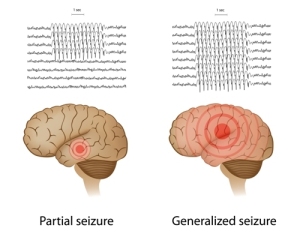Absence seizures were formerly called “petit mal seizures”.
There is a loss of consciousness for about 10 to 30 seconds during which the patient has generalized muscle twitching. Associated with this is a typical eye lid fluttering at a rate of about 3 flutters per second.
The muscle tone may or may not be lost. So, the child simply stops what he/she is doing, and after this pause where the above can be observed, continues with the prior activities as if nothing has happened. The child will not remember anything of the time during the absence seizure. These seizures happen often while the child is sitting and hyperventilation seems to bring them on. There is a genetic cause for these seizures and it is not surprising therefore that they occur in families.
Treatment
Several medications are effective in treating absence seizures. Clonazepam (Rivotril, Clonapam), valproic acid ( brand names: Depakene, Deproic, Epival, Epiject,Alti-Valproic) and ethosuximide( brand name: Zarontin) are all effective in controlling these seizures. For absence seizures, which do not repond to these medications often acetazolamide (brand name: Diamox) is effective.
References:
1. F Zara et al. Am J Hum Gen 2000 May 66(5): 1552-1557.
2. S Yeung et al. Europ J Paediatr Neurol 2000; 4(1): 31-33.
3. LS Leung et al. Neurosci Biobehav Rev 2000 Sep 24(7): 763-775.
4. DJ Yen et al. Epilepsia 2000 Sep 41(9) 1162-1166.
5. E Starreveld et al. Can Fam Physician 2000 Sep 46: 1817-1823.
6. The Merck Manual, 7th edition, by M. H. Beers et al., Whitehouse Station, N.J., 1999. Chapter 172.
7. The Merck Manual, 7th edition, by M. H. Beers et al., Whitehouse Station, N.J., 1999. Chapter 271, p.2415.
8. Ferri: Ferri’s Clinical Advisor: Instant Diagnosis and Treatment, 2004 ed., Copyright © 2004 Mosby, Inc.
9. Rakel: Conn’s Current Therapy 2004, 56th ed., Copyright © 2004 Elsevier







